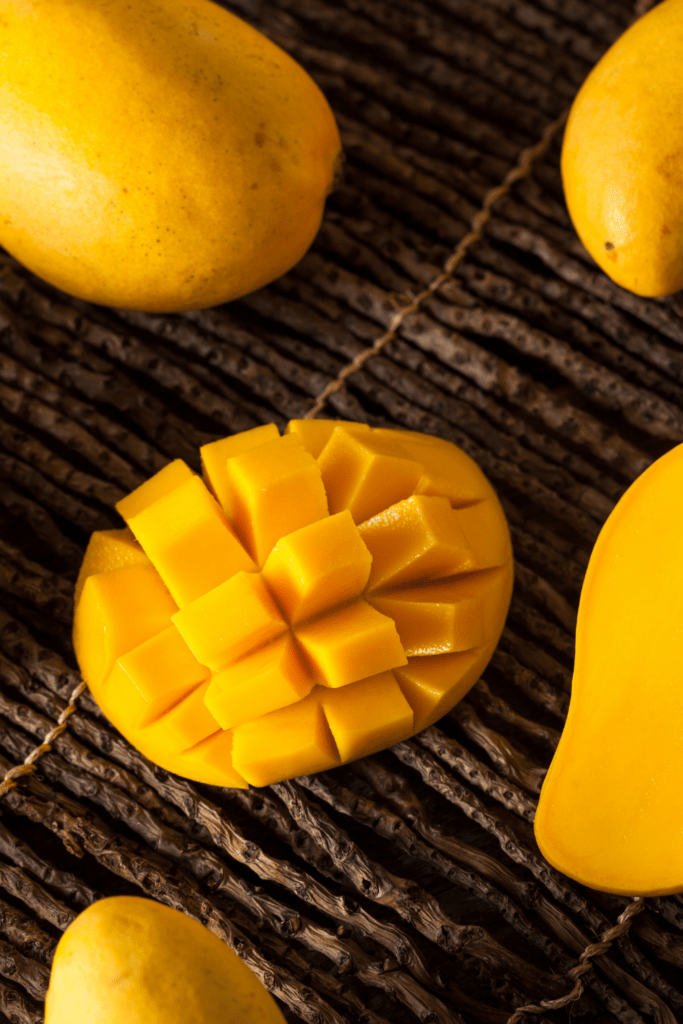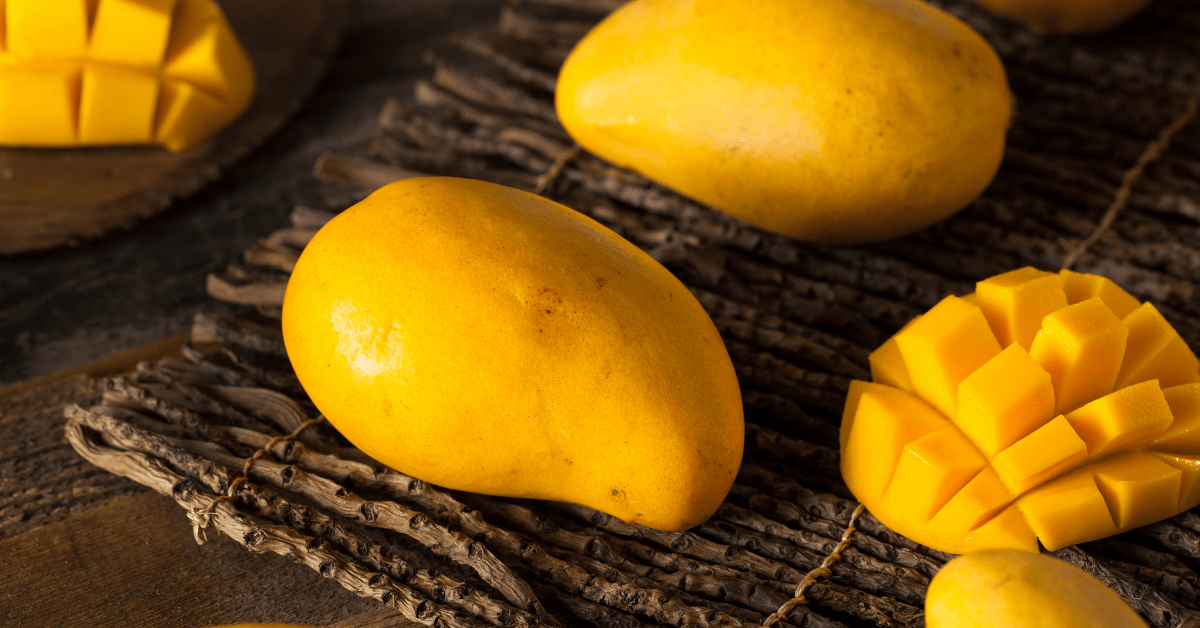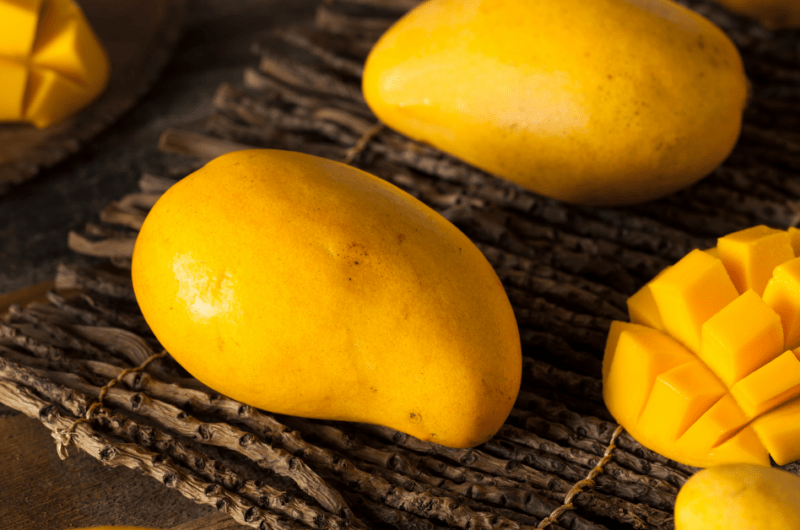If you’re wondering how to ripen a mango, you’ve come to the right place!
Mangoes are known as the king of fruits, and it’s not surprising.

These tropical fruits are just downright delicious! They’re super tender and juicy, and the flavor is so amazing.
They’re so sweet, I can eat three whole pieces at a time (minus the seed, of course)!
And because varieties of mangoes have different peak seasons, we get to enjoy this fabulous fruit all-year round.
Now, while some people prefer them green and tart, I like my mangoes ripe and sweet. That’s why I make sure my mangoes are ripened before I slice them open.
But did you know that there are ways to speed up a mango’s ripening process?
If you’re craving mangoes but have some under-ripe ones sitting at the pantry, I have you covered.
I’ll tell you all about different techniques you can use to get your mangoes to that sweet stage.
But first…
How To Tell If a Mango Is Ripe
For this, there are two main things you need to consider: the feel and the smell.
Ripe mangoes are soft and plump. So give the fruit a gentle squeeze.
It should have a little give when you press on it. It should be soft, yet not mushy.
Next, give the stem end a sniff. If it smells sweet and fruity, it’s ready to eat. But if you smell nothing at all, give it a few more days.
Now, unlike other fruits, looks don’t matter in mangoes. The color of the mangoes could be sometimes deceiving, so don’t be fooled!
Mangoes come in different colors – red, yellow, and green. Just because they’re vibrantly red or yellow doesn’t mean they’re sweet.
Also, if you see black spots in certain areas of the mango, don’t fret. That’s not an indicator of damage or over-ripeness.
It could sometimes even be a good sign! Just pay attention to the feel and the smell of the mango, and you’re good.
How to Ripen Mangoes
There are a few things you can do to help your mangoes achieve ripeness.
1. Patience
If you’re willing to wait several days (I’d say 5 to 8), the simplest way is to store mangoes at room temperature.
Do not refrigerate unripe mangoes, as this will stop or delay the ripening!
To protect the mangoes from insects, place them in a plastic bag or a jar with air flow.
2. Paper Bag
To speed things up a little, place your mangoes in a paper bag or wrap them in newspaper. Store at room temperature and check after 2 days.
Here’s why this technique works: mangoes release ethylene, an odorless gas responsible for ripening fruits.
Now, if you seal the fruit in a paper bag or newspaper, you trap the ethylene around the mango, making it ripen much faster.
Oh, while you’re at it, you may also want to throw in some apples or bananas in the paper bag.
These fruits produce ethylene as well. The more they are exposed to ethylene, the faster they ripen.
Do not close the bag entirely, though. There still needs to be a little gap for air and gas to escape the bag. If not, it can cause mold and mildew.
3. Popcorn and Rice
Drown those unripe mangoes in popcorn kernels or uncooked rice! It’s the same concept as the paper bag technique.
With this method, you can expect results within a day! Mangoes will ripen so fast, that you’ll have to check after 6 or 12 hours.
You won’t want them to stay in there longer, or else you risk over-ripening them.
Other people also swear by storing mangoes in a cardboard box filled with hay. I don’t have access to hay, so I haven’t tried this.
If you have, please let me know if it works!
4. Microwave Method
If you can’t wait any longer and just want your mangoes immediately, give them a spin in the microwave.
A word of caution, though – microwaved mangoes do not taste as good as fresh mangoes.
Here’s how to do it: poke the mango with a knife in 4 to 5 areas. This will allow steam to escape as it microwaves.
Wrap the fruit in a towel and microwave for 10 seconds. Check if the fruit has softened.
If not, microwave it for another 10 seconds. Keep doing the process until you achieve the desired softness.

How to Properly Store Mangoes
This depends on how ripe or unripe your mangoes are.
Room Temperature
As I’ve said, unripe mangoes should be kept at room temperature.
Refrigerator
But once they have ripened, transfer them to the fridge. Ripe mangoes will keep fresh for up to 6 days in the fridge.
Unpeeled mangoes may go straight to the fridge. For peeled/sliced mangoes, place them in an air-tight container, then refrigerate.
Freezer
You may also store your mangoes in the freezer to increase their shelf-life.
It will not have the same consistency once defrosted, though, but it will still make a good ingredient for shakes or baking.
Frozen mangoes will keep well for up to 10 months.
- To freeze mangoes, slice them into chunks and place them in a baking sheet, making sure each piece does not touch one another. Freeze the baking sheet for 3 to 5 hours. Then transfer the frozen mangoes into a freezer-safe bag. Squeeze out as much air as you can and then seal. Label the bag and freeze.
- Or, you could also puree the mangoes, pour the juice into ice cube trays, and freeze. This is a great technique for making shakes and juices!
- Lastly, you can also soak your mangoes in simple syrup. This will extend its lifespan to up to a year. To make the syrup, add 2 cups of water and a cup of sugar in a pan. Stir until the mixture has come to a boil. Let it cool to room temperature. Place the mangoes in an air-tight container. Pour the syrup over the mangoes, but make sure to leave an inch of headspace. Cover the container with the lid and freeze.










